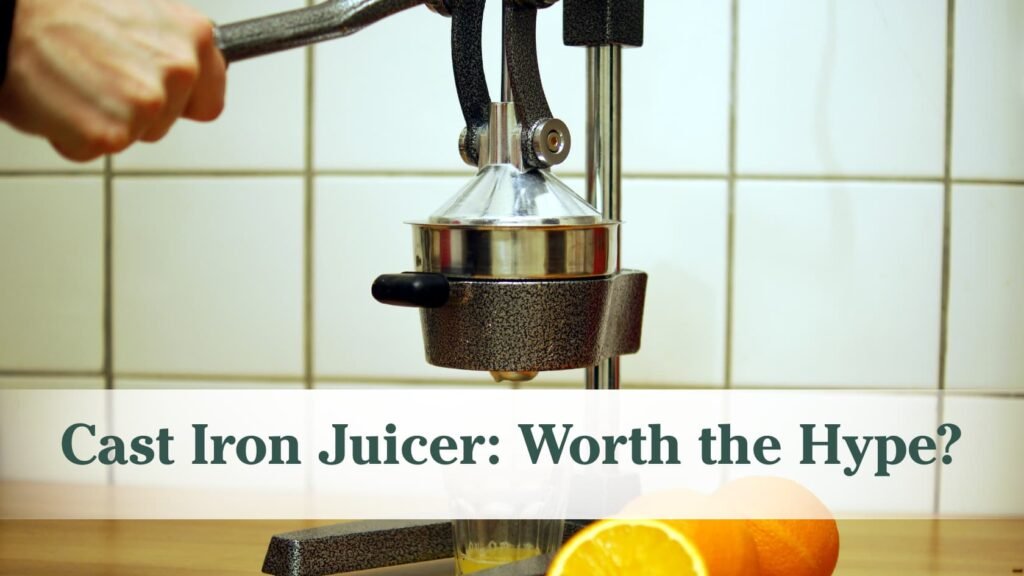The Rise of the Cast Iron Juicer on TikTok
In recent months, the cast iron juicer has emerged as a trending kitchen gadget on TikTok, captivating users with its unique design and functionality. Even myself, who doesn’t really drink juice often, had considered getting one after seeing videos of it. This innovative tool, characterized by its durable cast iron construction and vintage aesthetic, has quickly gained attention for its effective juicing capability as well as its visual appeal. Various influencers and content creators have showcased the juicer in entertaining and informative ways, leading to widespread interest and user adoption.
The design of the cast iron juicer sets it apart from its plastic and stainless-steel counterparts, appealing to consumers looking for an eco-friendly and long-lasting option.
Influencers have demonstrated its ability to extract juice efficiently from fruits such as limes, pineapples, apples, oranges, and more, leading to a renewed fascination with fresh juicing among health-conscious individuals. Videos share their juicing experiments, showcasing creative recipes and highlighting the versatility and cost effectiveness of the cast iron juicer compared to store bought juice.
Expert Opinion: Registered Dietitian Discuss the Cast Iron Juicer

The cast iron juicer has gathered considerable attention on social media platforms, particularly TikTok, prompting many to consider its role in a healthy lifestyle. As a registered dietitian, I will give my opinion on juicing with a cast iron juicer and how it stacks up to store bought juice.
Nutritionally, making juice at home has the potential to offer slightly higher nutrient contents than store bought juice. Over time as a fruit of fruit juice sits on the shelf the nutrient levels degrade or reduce. If you have the option to juice fresh picked fruit or frozen fruit, you could have a juice with more nutrients compared to store bought.
Additionally, store bought juices are often pasteurized which is helpful to make it more food safe and extend its shelf life, however, some of the nutrients can be destroyed in the heating process.
However, juices prove no nutritional benefits over eating the whole fruits or vegetables.
One of the essential things I consider as a dietitians is the impact of consuming juice versus whole fruits. While juicing can provide a concentrated amount of nutrients, it often lacks fiber, which plays a vital role in digestive health. Fiber is something most adults lack in their overall diets.
Whole fruits and vegetables deliver fiber that slows down sugar and starch absorption, which can help to regulating blood sugar levels. If you do consume juice, consumption should be in moderation and complement a diet rich in whole foods rather than replace them. This approach helps reinforce the idea that balance is quintessential in achieving nutritional adequacy.
Additionally, as mentioned earlier, store bought juices are pasteurized to improve their food safety and extend shelf life. Fresh juice should be consumed immediately as dangerous bacteria could grow the longer the fruits sits which could lead to foodborne illness [1]. This could be particularly dangerous for children, older adults, pregnant women, and people with weakened immune systems [1].
Ultimately, the juicer may serve beneficially when used properly, but it is crucial to consume a variety of fruits, vegetables, and whole foods for optimal health benefits.
In considering the role of juicing within a balanced diet, for yourself its best to discuss with your doctor or registered dietitians for a more individualized approach based on personal health goals and dietary preferences.
Pros and Cons of Using a Cast Iron Juicer
Despite the glowing reviews on TikTok about the juicer, it is still important to look at this investment from all angles. Its unique design and composition present several benefits and drawbacks that are worth contemplating for individuals considering its addition to their kitchens.
Pros
One of the most significant advantages of using a cast iron juicer is its durability. Made from heavy-duty materials, these juicers may warp or break less compared to their plastic or lightweight metal counterparts. This robust construction could ensure longevity and consistent performance over time.
In addition to durable design, they also considered cleanup with its design. It appears most cast iron juicers have two removeable stainless steal parts that are dishwasher safe. This is a significant advantage to some electric juices that have several parts with small or hard to clean areas.
Another noteworthy benefit is the quality of juice produced. Cast iron juicers have been shown in videos to extract juice efficiently, and for some it could offer benefits of a juice with a higher nutrient content. Furthermore, you can press fruits multiple times to ensure you are extracting as much juice as you can with this juicer.
Cons
However, potential drawbacks should be taken into account before purchasing a cast iron juicer.
One concern is juicing can be time consuming. With the potential of harmful bacteria growth it is best to drink juice fresh after pressing it and not let it sit. Additionally, because of the potential for contamination with harmful bacteria, fresh juices as opposed to pasteurized, may not be appropriate for certain groups with weaker immune systems.
Another noteworthy drawback is that significant amount of fruit required to yield enough juice for consumption can deter some potential users, as it may not be as economical or efficient for smaller households. Furthermore, depending on the fruit, season, and your location, juicing may be significantly more expensive than buying juices from the store.
In weighing the pros and cons of the cast iron juicer, consider ones personal preferences, lifestyle, and needs. If you already have a juicer that works well it may make even more sense to stick with what you have. Understanding both the advantages and disadvantages can aid in making an informed choice about whether to incorporate this tool into the kitchen.
Juicing vs. Smoothies vs. Whole Fruits: Making the Healthier Choice
As mentioned earlier, juicing can be part of a healthy diet but, how does juicing stack up against smoothies, and smoothies against whole fruits and vegetable? Each method offers a different way of consuming a fruit or vegetable with potentially different nutritional benefits and understand their implications on health to make informed decisions.
Juicing involves extracting the liquid from fruits and vegetables, during which the fiber is largely removed. This process can create a high-sugar drink, which may lead to rapid spikes in blood sugar levels for people with diabetes. While juices can provide a concentrated source of vitamins, they often lack the fiber necessary for digestive health. Juicing may be appropriate for those needing a quick source of nutrients or when recovering from illness, but should be consumed in moderation to avoid excessive sugar intake.
On the other hand, smoothies retain the fiber from whole fruits and vegetables, making them a more balanced option. The fiber aids in digestion and can help maintain stable blood sugar levels, promoting satiety and reducing the likelihood of cravings. When blended, smoothies allow for the inclusion of various ingredients such as nuts, seeds, and protein powders, enhancing their nutrient profile. Smoothies are a nutritious meal replacement or snack, especially when incorporating a variety of food groups.
Whole fruits and vegetables are another excellent choice, offering different combinations of dietary fiber, vitamins, and minerals, to support health in one way or another. Eating fruits and vegetables in their whole form or cooked contributes to better digestion and satisfaction. The consumption of whole fruits is associated with lower risks of chronic diseases, including heart disease and diabetes. As a registered dietitians I always encourage including a variety of fruits and vegetables in the diet, to get a variety of different nutrients.
Ultimately, the decision between juicing, smoothies, or whole fruits should align with individual dietary needs and lifestyle preferences.
Take Away
Cast iron juicers have recently become popular and appear to be a effective juicing tool. However, fresh squeezed juice or even getting a new juicer is not for every one. Try to think about your individual needs, your household, and your overall lifestyles. Need some more thought? Try talking it over with a Registered Dietitian to make the best decision for you.
I see patient one-on-one through Nourish, which is a virtual practice offering nutrition counseling. Check out the link below to my counseling page to learn more about working with myself or another dietitian at Nourish.
